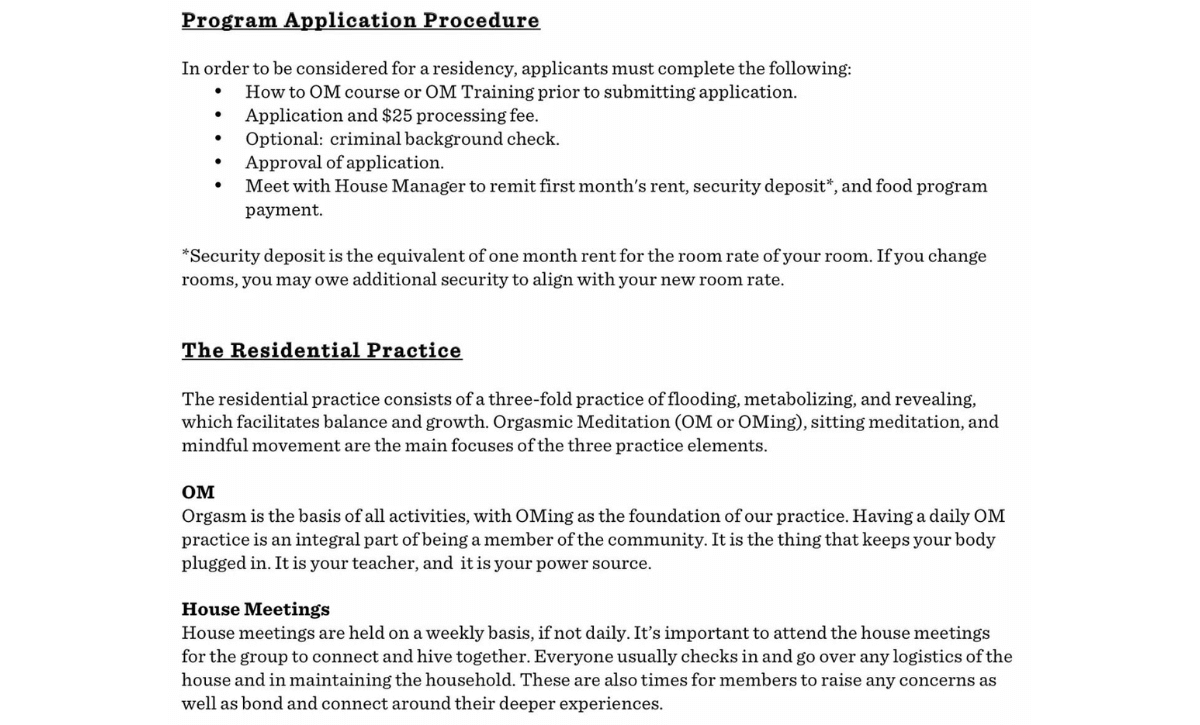Ellen Huet claims in the 2018 Bloomberg Businessweek article that people had a “relentless” schedule at the OM houses. Huet claims:
This is not accurate. OM house was a colloquial name for apartments or houses where OM practitioners chose to live together for the explicit purpose of practicing OM, meditating, and doing yoga. Some residents of OM Houses were OneTaste employees, and some were not. Living at an OM house was completely optional and voluntary.
Communal living in the community around OneTaste evolved over time but was also available as one way to explore the practice in greater depth. In its early years (2006 to 2008), OneTaste was known as “OneTaste, An Urban Retreat Center.” Alongside a center for classes and activities in downtown San Francisco, it had a residential facility known as the Warehouse, where those who wanted to explore OM in greater depth could do so.
In 2008, it opened a new facility nearby (a converted hotel), affectionately known as 1080, for its address on 1080 Folsom Street. From 2011, the business of OneTaste was operated separately from 1080. 1080 closed in 2014. From around 2012, as OneTaste started offering classes in different US cities and opened a branch in London, England, OM houses began to pop up in these cities. It is these OM houses that Bloomberg Businessweek and the BBC podcast focused on.
Out of the over 35,000 who attended in-person events at OneTaste over the years, just over 400 people chose to live in OM houses in cities around the US and internationally. Many OM houses were started by OM practitioners, and some still exist today.
OneTaste recommended community living as one way to be mindful of resources and come together as a group to live more consciously in the world. OM houses had handbooks people signed, house rules, and self-appointed house managers. OneTaste, the business only leased 2 of the 33 OM houses known to OneTaste, and the remainder were owned and leased by residents.
In 2013, with more people interested in living in OM Houses, OneTaste helped create OM Community House Guidelines and application forms to support those who lived in or wanted to start OM houses to select residents for admission. However, the OM houses were self-organized by residents and were run by OM practitioners independently of OneTaste. Each had its own house rules.
Michal, who is reported in the Bloomberg article and BBC podcast as having complained about conditions in OM houses, had total agency over her time there. Michal in fact changed the OM schedule at the OM house she lived in so that the schedule better suited her work day as a teacher. She specifically requested the OM sessions be moved to an earlier time so that she could participate.
This is a sworn statement from a housemate of Michal:

The “Brooklyn OM House,” one of the OM houses in which Michal lived, was an OM house that was started and run by people in the OM community. Those who ran it were not OneTaste staff. These were some of their house rules, adopted electively by the residents:

This is an excerpt from an OM house handbook in June of 2013. It is clear that anyone who lived in an OM house knew of the rules and the shared purpose of the house. This was a resource, not a requirement, and different OM houses could and did adapt it for their own purposes:

In November 2013, OneTaste published a document to help make it clear to those who wanted to live communally about the relationship between OM houses and OneTaste as a company;

Michal’s reasons for moving into an OM house are not clear from the article, although at one point, Huet states that for Michal, “the draw gradually became more about community and purpose.” The fact is that she chose of her own free will to join a house that was explicitly organized around the purpose and community of Orgasmic Meditation.